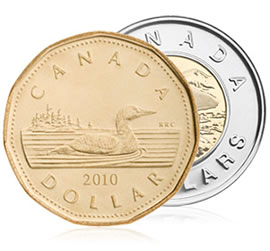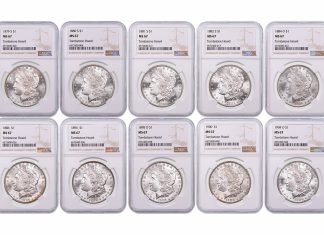 Ottawa, Ontario — As part of the Government of Canada’s budget announcement to modernize Canada’s currency , the Royal Canadian Mint will change the composition of one-dollar and two-dollar coins, using the Corporation’s cost-effective patented multi-ply plated steel technology.
Ottawa, Ontario — As part of the Government of Canada’s budget announcement to modernize Canada’s currency , the Royal Canadian Mint will change the composition of one-dollar and two-dollar coins, using the Corporation’s cost-effective patented multi-ply plated steel technology.
The current composition for the one-dollar coin is bronze plated nickel, while the current composition for the two-dollar coin is, for the inner core, aluminum bronze (copper, aluminum and nickel), and for the outer ring, pure nickel. The primary new composition of both coins, to be launched at the beginning of 2011, will be multi-ply plated steel.
The Mint is currently working collaboratively with key stakeholders to minimize the impact of this composition change on their day-to-day operations. The new coins will bear the same look and feel as the current bronze and nickel one-dollar and two-dollar coins.
The Mint’s multi-ply plated steel technology is a unique electroplating process which deposits thin, alternating layers of nickel and copper over a steel core, or "blank", to produce the best quality, most economical nickel and copper based circulation coins available.
Canada’s one-cent, five-cent, 10-cent, 25-cent and 50-cent circulation coins have been produced with this technology since 2000. Multi-ply plated steel coins are proudly produced by the skilled technicians of the Mint’s Winnipeg facility where all circulation coins, for Canada and countries from around the world, are produced.
About the Royal Canadian Mint
The Royal Canadian Mint is the Crown Corporation responsible for the minting and distribution of Canada’s circulation coins. An ISO 9001-2008 certified company, the Mint is recognized as one of the largest and most versatile mints in the world, offering a wide range of specialized, high quality coinage products and related services on an international scale. Visit www.mint.ca for further information on the Mint’s history, products and services.






Why would they do that when the seignorage for those coins is already very high? There’s a certain wisdom in having a coin composition with an intrinsic value that’s not too low in order to avoid counterfeiting. I certainly hope the United States isn’t considering such things for our 10¢ through 100¢ coins.
Proudly produced? I can understand publishing press releases, but at least edit out the puffery.
I wonder if this technique would work for our penny. Of course the US would have to pay a license fee for the patent so maybe it wouldn’t be cost effective anyway in the end.
Why should we expect the US to listen to anything that Canada does? After all, in this country coinage decisions are made by members of Congress who are more concerned about the size of the letters in “In God We Trust” than they are about whether we have an effective coinage system. Otherwise we wouldn’t be wasting $700 million to $1 billion a year printing $1 bills and refusing to use $2 notes or coins. And I’m sure if anyone proposed buying Canadian technology some back-bench bonehead would be railing about how Canada is a “socialist/communist dictatorship” because they have… Read more »
Article mentions the penny, which Canada no longer mints. Otherwise it sounds as though they’re trying to save some nickel (metal, the coin having changed years ago). See my note on the companion article on the US not changing its coinage composition. Sounds like they’re way ahead of us. Again.